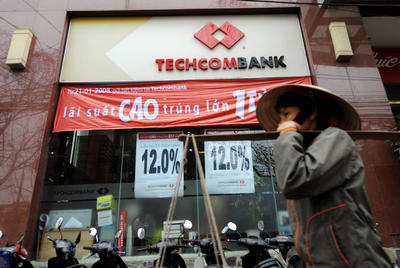The State Bank of Vietnam was also under pressure to permit bank ownership by large state-owned enterprises — that is to say it allowed some large ‘economic groups’ to have interrelated ownership and lending. In 2011 Vietnam tightened policy settings to tackle double-digit inflation and, as a result, exposed the significant weaknesses in its banking sector. Non-performing loans have been officially estimated at around 6–8 per cent of bank assets, but the real figure is much higher — mainly because of gaming behaviour on the part of some banks.
The resultant lack of confidence among borrowers and investors in the banking sector, and the banks’ uncertainties over their balance sheets and the path of future regulations, have resulted in a slump in credit growth to an estimated 7 per cent in 2012, contributing to a fall in GDP growth to a 13-year low of 5.03 per cent. So the State Bank of Vietnam must act on its roadmap and successfully restructure the banking sector by its target date of 2015.
But in the 12 months after Decision 254 was announced, the Bank has done little apart from enforce mergers of five (out of ten targeted) financial institutions. While two recent announcements — that Vietnam will set up an asset management company to take over and ‘work out’ the non-performing loans of Vietnamese banks, and create a high-level coordinating committee to oversee the process of bank restructuring — are a welcome sign of action, Vietnam’s banking sector needs further reform.
So far, apart from a few minor bank runs, Vietnam has avoided a major banking crisis. That’s not to say it is safe in the future. When the Asian financial crisis began in 1997, Indonesia also had non-performing loans of around 8 per cent of total banking assets. Once bank runs began and the government was forced to guarantee deposits in order to stabilise the banking system, non-performing loans jumped rapidly and quickly engulfed the banking sector. The reason is simple. When large enterprises own the banks they borrow from, they are happy to default on their loans once they know that taxpayers, not themselves, risk losing their capital in paying back depositors.
So it is important that the State Bank works, and is seen to be working, in conjunction with other ministries in unwinding the bank ownership positions of large economic groups. That is the only way to ensure these groups don’t move again into non-core businesses such as banking. Furthermore, according to Decision 254, the state-owned commercial banks will still be the dominant players in a restructured Vietnamese banking sector. These banks must not be given undue incentives to lend to state-owned enterprises, and those state-owned companies to whom credit lines are given should be sound and profitable enterprises. For these reasons, state-owned enterprise reforms and bank restructuring in Vietnam will only be effective if they occur in tandem. This gives substance to the intergovernmental coordinating committee that is currently being set up.
The State Bank must also look at the problems of cross-ownership among smaller Vietnamese banks. If Bank A, for instance, is required by the State Bank to increase its capital, it issues shares, which are bought by Bank B using B’s depositors’ funds. This defeats the original purpose of making Bank A’s owners risk more of their capital, and instead raises the risk of the whole banking system.
Other types of gaming behaviour involve non-performing loans. If Company C, for example, has a loan that is non-performing in Bank A, C can issue bonds. Bank A then takes up the bonds, and Company C uses the funds from the bond issue to pay off the loan with Bank A. This way the non-performing loan from Company C disappears from the balance sheet of Bank A — but Company C still owes the same amount (or an even larger amount) to Bank A in the form of bonds.
Another form of gaming occurs when banks hedge against non-performing loans. The State Bank allows collaterals against a loan to be deducted before the banks make provisions against the loan going bad. Some banks simply overvalue the collaterals they hold in order to reduce the amounts needed to insure against a bad loan.
These types of gaming behaviour make investors and depositors nervous, for good reason. They also undermine the credibility of the State Bank as a prudent regulator.
That credibility will be particularly important as foreign banks become more active in the domestic market. The State Bank needs to work closely with banking regulators around the world. When a foreign bank is in trouble, for instance, whether the Vietnamese branch of that bank is to be rescued, and by whom, could become contested.
In short, bank restructuring depends on a more effective State Bank. Not only does the State Bank of Vietnam have to be a credible and prudent regulator and formulator of monetary policy, it also has to communicate its policy stance and intentions to the public. In this respect, there is still a way to go in Vietnam’s transition into a market economy.
Suiwah Leung is Associate Professor of Economics at the Australian National University.

